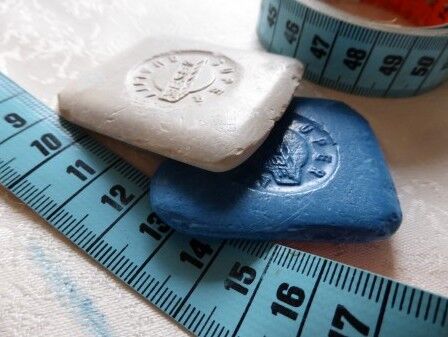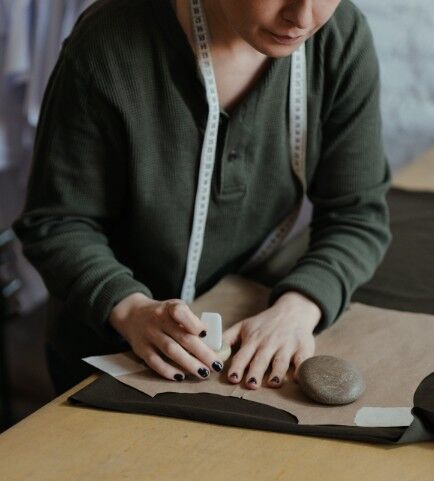When you have a sewing project lined up, there are certain steps to be taken before you start your machine. You have to get the best kind of fabric, choose your fabric-cutting tools, and of course, trace the pattern before cutting it. This tracing of transferring marks is usually done through a fabric chalk or marker. These can then be washed off or disappear on their own.
As with all sewing equipment, the use of fabric markers and chalks needs to be learned properly. There’s no one right way to go about tracing sewing patterns, but there are several choices one can choose from. The following tips will hopefully help you use these tools in the best manner:
Choosing the Right Tool
If you’re a novice sewer, you might think that choosing between fabric markers, pens, and chalks is just a matter of preference. This is only true to a certain extent, as there are different materials that are suitable for specific kinds of fabric. Here’s a guide to sewing marking material.
Sewers can also experiment with the fabrics and tools they have on hand to save time and hassle. They can use their pen, pencil, or a piece of chalk using a scrap of any fabric that they are considering for a project. Even if you think you have the right tool for the job. It’s recommended to conduct this experiment first. You don’t want to end up with a light-colored garment that has indelible markings all over it. Experienced sewers might be less likely to have this problem, but it’s better to be safe than sorry.
Using Disappearing Ink
Among the most popular kinds of fabric pens for marking material before sewing is the type that has disappearing ink. Most sewers own one if they know about it. The problem here is that the marks might disappear all too quickly before you’ve had a chance to cut the fabric. On the bright side, any marks that are left can be washed out quite easily.
Many sewers complain that such pens might dry out quickly. You can combat these problems by having a few spares on hand at all times, The main advantage of these pens is that you get precise lines and markings. This also makes it easy to make circles or tiny dots. Using brightly-colored pens will be good for working with light fabrics. If you don’t want to wait, a flick of water or a touch from the iron can eliminate the marks altogether.
Using Tailor’s Wax
Some fabrics might work best with tailor’s wax instead of the usual chalks or markers. This is good for marketing any changes you want to make on muslin fabric. On the downside, its marks can be quite a challenge to wash out. Many manufacturers claim that their wax can be melted when you use an iron on the material, but this doesn’t always work out. In practice, this option might be best saved for using on wool fabrics.
The upside here is that the wax slides onto most materials and leave you clear lines to follow. It also won’t brush away or fade too easily, so you’d be assured of getting your work done. However, you do risk staining your fabric, sometimes permanently.
Using Tailor’s Chalk
The good old tailor’s chalk is good for marking most kinds of fabric, but it’s best for textured and/or thick materials. It leaves smooth lines, so the tracing is easy. The chalk is also brushed away quite easily or fades on its own.
On the other hand, this chalk can be quite problematic to handle. It can break very easily, crumble off, and even lose its color over time. You also have to keep renewing and sharpening its point as that wears away very rapidly too. Finally, the markings from this chalk might brush or fade too quickly, not leaving you with enough guidance for cutting.
The Water Soluble Pencil Option
This is a colored pencil that is designed for washing easily from your material. You might have to go for the better brands here, as the cheaper ones can be risky. If you get a pencil with a hard lead, you’d need to apply some heavy pressure in order to leave a mark. You’d have to be careful here, or the fabric might stretch out.
If you do go for this option, it’s best to go for the softer ones. Quality is of the essence here, as some soft leads might shatter inside and be useless. It’s probably wise to use these pencils for the heavy fabrics such as denim or canvas.
Chalk Sticks
Another chalk option is the simple chalk stick, much like the kind we were used to in school. A largish pencil sharpener will make sure you get a sharp point easily. While the sharpening sessions might be frequent, such chalks are one of the most inexpensive marking methods.
These chalks can be used on smooth and preferably thick fabrics. They might crumble and fade too easily on the more textured materials, so be careful here. The upside is that you can easily find many different colors to work with, which might make your complex projects easier to follow.
How to Trace
There are several methods for tracing the pattern you want on your fabric. For using fabric markers and chalk, you can put the paper pattern on the piece of fabric. Match the edges as best as you can and insert the pin where you want to transfer that mark. You can then slightly lift the pattern and mark the place when the pin went through. If you’re pinning two layers, lift up the top one and marker inside as well.
Other Options
Markers and chalks are all very well, but you might even make do with a good old ballpoint pen if the project isn’t too dainty. If someone is just starting to learn sewing, they might to want to invest too much time or money into marking tools. Using whatever’s on hand, as long as we can expect it to wash out, might work in a pinch.
There are also some methods for marking fabric which don’t involve tools like fabric markers or any kind of chalk. One of these is using carbon paper, where you can use any kind of pencil or pen to press down and make a mark on the fabric. Alternatively, some sewers might want to use light basting to make out their pattern. Whether you prefer one way or the other, it might be a good idea to make room in your sewing storage system for several of the tools we’ve discussed above.
Conclusion
There are quite few choices of markers and chalks when it comes to marking your fabric for precise sewing. You’d have to strike a balance between the tools you can afford and are comfortable, while the type of fabric in use is also a major influencing factor. It’s not too hard to find just the right tool, though, but the initial testing is always a must.


